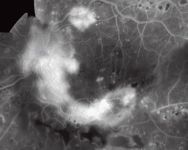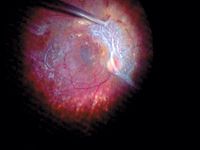Article
Procedure guided by classification of vitreous detachment
Recognizing the stage of vitreoretinal detachment can help the surgeon determine the surgical approach and the gauge of the instrumentation to obtain the best outcomes.

In addition, use of anti-vascular endothelial growth factor (VEGF) and small-gauge instruments can be useful in vitreous detachment repair, said Dr. Corcostegui at the annual meeting of the American Academy of Ophthalmology.
"The surgical indications for diabetic retinopathy have remained the same for the past 20 years: vitreous hemorrhage; macular tractional retinal detachment; rhegmatogenous and tractional retinal detachment; and tractional macular edema. Pars plana vitrectomy and peeling of the internal limiting membrane for nontractional macular edema remain controversial," Dr. Corcostegui explained. He is from the University of Barcelona, Institut de Microcirurgia Ocular, Barcelona, Spain.

Type 2 is defined by broad vitreoretinal attachments, with attachments larger than 1 disc area in size and the presence or absence of underlying traction. The complication rate associated with this type of vitreoretinal detachment increases to 5% to 6%.
Type 3 is characterized by vitreous attachment at the disc along the arcades and over the macula. The vitreous is detached between the arcades and the vitreous base. The rate of surgical complications can increase to 7%.
Type 4 is associated with vitreous attachment from the disc and major vascular arcades out to the extreme periphery. The vitreous is detached only over the macula. A premacular hemorrhage can accumulate in the low-lying vitreoretinal pocket, which is an indication for surgery. The surgical complications increase to 8% to 10%.
Finally, type 5 is the most complicated of the stages. There is no PVD, i.e., the vitreous is attached everywhere, Dr. Corcostegui emphasized. The surgical complication rate ranges from 12% to 15%.

"In the more complicated cases, we prefer using 20-gauge instruments because they allow us to perform a good bimanual procedure and many instruments are available," he said.
When operating on patients with types 2 to 5 vitreous detachments, 0.05 ml of either bevacizumab (Avastin, Genentech) or ranibizumab (Lucentis, Genentech) is injected 2 to 7 days preoperatively, which decreases the proliferation of new vessels, shrinks the collagen tissue and the size of the retinal vessels, and decreases the macular edema as seen on ophthalmoscopy. Angiography shows dramatically decreased leakage following this pretreatment.
Dr. Corcostegui especially likes 23-gauge instrumentation because he can operate through a small port and there is higher efficacy when cutting membranes.
"Recognizing the degree of vitreoretinal attachment can be useful and can help the surgeon estimate the complication rate. Anti-VEGF drugs are helpful to the surgical technique and small-gauge instrumentation can help in membrane dissection," he concluded.
Newsletter
Don’t miss out—get Ophthalmology Times updates on the latest clinical advancements and expert interviews, straight to your inbox.




